 |
|||||||||||||||||||
|
November 11, 2004
In This Issue of The Acid Staining Newsletter An Ounce of Prevention
In past newsletters we have talked a lot about removing problem coatings and stains from the slab prior to acid staining. In our last issue we dealt with remodel jobs in which the floor had multiple coats of “concrete paint” on it. We have since tried Franmar’s Soy Gel and found it to be easy and effective. The Soy Gel needs to be applied quite thickly in order to work (about 1/8”). It should be allowed to sit on the coatings for at least 20 minutes without disturbance. If you need to leave it for several hours, that is okay, too. If it dries out you can spray it with water to reactivate it. The paint can then be scraped up with a razor scraper. We were able to get through the four coats of paint on our floor with just one application. However, this is likely to be an expensive process. It took us about a gallon of Soy Gel to clean 25 square feet. Two and a half gallons cost us $128 with shipping. This comes out to $2.50 per foot just for the materials. To reduce this cost, one can order a much larger amount for a small increase in shipping charges; but be advised that with labor added, you might need to charge $4 per square foot just to pre-clean the floor! I heard from several stainers who had tried the Peel-Away type of system and were pleased with it. We have not yet found this product to test it and compare in price with Soy Gel.
|
|||||||||||||||||||
|
Let’s return to the simpler problem of a new building slab. We recently had a day- long task of floor cleaning on a small townhouse we were scheduled to stain. We had an educated builder, who made a real effort to protect the slab. In fact, he said that he covered the floors from wall-to-wall with paper twice during earlier stages of building. This guy builds many houses at once, however, and there is not always a supervisor on the site. When the painter arrived, he pulled up all the paper and sprayed white latex paint on the walls right down to the slab, leaving eight or ten inches of overspray along every wall edge. As if this were not bad enough, he dragged all the baseboard molding strips into the living room, laid them out on the floor, and sprayed several coats of paint on them. In one bedroom his sprayer must have gotten clogged, so he aimed it at the floor and sprayed rivers of paint in the corner while he worked out the problem! |
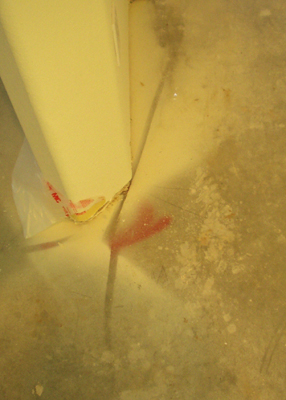 |
||||||||||||||||||
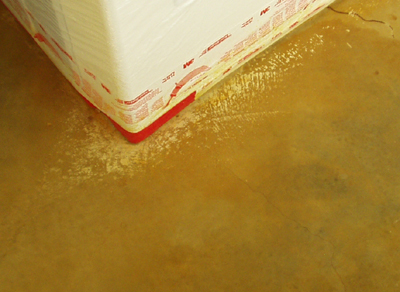 |
|||||||||||||||||||
| The paint was so thick that our crew had to brush heavy citrus cleaner thickly along every wall, let it penetrate and then scrape the paint up by hand with wide razor scrapers. Some of the paint had penetrated into the texture of the slab so that no amount of scrubbing could remove it. We had to stain over it and faux paint it out at a later stage (see photos). | |||||||||||||||||||
|
What magic bullet could have prevented this? One of my past seminar students thinks he might have the answer. Ray Anger owns Decorative Concrete Staining and Scoring Inc. in
|
|||||||||||||||||||
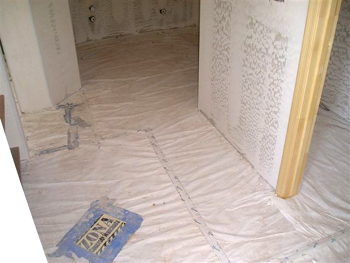 |
|||||||||||||||||||
|
When it comes time for Ray to stain the floors, he cuts the Tyvek with a razor blade neatly along the edges. If the Tyvek is not too soiled, he can cut further out into the room and fold it back up the wall, taping the upper edge to create his wall-masking or the necessary protection for the wooden bases of cabinets and door frames. Another ounce of prevention which Ray installs early on, is what he calls “contractor education signs.” These are brightly colored notices in English and Spanish which declare certain rooms to be in the stained floor zone. He staples these up to the framing members and sometimes even outlines the locales to be stained with yellow caution tape. The photos here show some of Ray’s covered floors and some of his notices. Tyvek is not an inexpensive product and this extra labor on the front end does, of course, cost money. |
|||||||||||||||||||
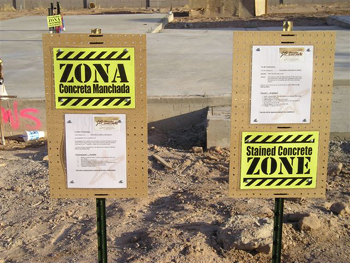 |
|||||||||||||||||||
| But Ray swears that it makes the whole stain job go much more smoothly and that the Tyvek covering does not appear to cause any lines or shadows where the concrete might be curing differently due to his covering or the tape holding it together.
It seems to me that this would be especially cost-effective if you have a crew which is new to staining and does not have knowledge on how to remove various contaminants from the floor. The post-framing floor covering process could be worked into the price and into the standard routine of the crew, whereas cleaning problem areas later is likely to require more on-the-job improvisation. GG |
|||||||||||||||||||
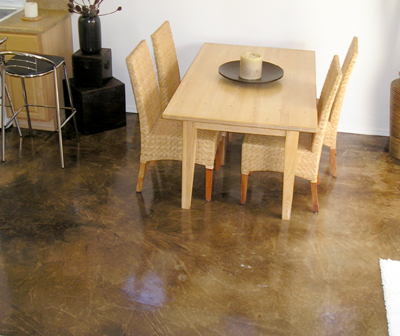 |
|||||||||||||||||||
| Completed Floor by Ray Anger after using Tyvek Housewrap | |||||||||||||||||||
|
|
|||||||||||||||||||
